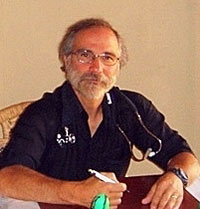May 04, 2018

Saladin May Have Suffered from Typhoid Fever
Saladin may not be well known in the West, but even 800 years after his death, he remains famous in the Middle East. Born in 1137, he rose to become the Sultan of an enormous area that now includes Egypt, Syria, parts of Iraq, Lebanon, Yemen and other regions of North Africa. He successfully led armies against the invading Crusaders and conquered several kingdoms. Historians have described him as the most famous Kurd ever.
Even today, however, Saladin’s death remains a mystery. The illness began in 1193, when he was 56. After two weeks, the Sultan was dead. Some have speculated that fever was a prominent symptom of the illness.
 After closely examining a range of evidence about Saladin’s condition, Stephen J. Gluckman, MD, professor of medicine at the University of Pennsylvania School of Medicine, has developed a diagnosis. Dr. Gluckman theorizes that typhoid, a bacterial disease that was very common in the region at the time, is the most likely culprit. Today of course, antibiotics could have greatly helped Saladin. But in the 12th century these medicines did not exist.
After closely examining a range of evidence about Saladin’s condition, Stephen J. Gluckman, MD, professor of medicine at the University of Pennsylvania School of Medicine, has developed a diagnosis. Dr. Gluckman theorizes that typhoid, a bacterial disease that was very common in the region at the time, is the most likely culprit. Today of course, antibiotics could have greatly helped Saladin. But in the 12th century these medicines did not exist.
Dr. Gluckman delivered his diagnosis at the 25th annual Historical Clinicopathological Conference, held Friday, May 4 at the University of Maryland School of Medicine. The conference is devoted to the diagnosis of disorders that afflicted historical figures; in the past, experts have focused on the diseases of luminaries such as Lenin, Darwin, Eleanor Roosevelt and Lincoln.
Dr. Gluckman, an expert on parasitic disorders, has provided care and taught in many countries around the world. He carefully reviewed what is known about the Sultan’s medical history. “Practicing medicine over the centuries required a great deal of thought and imagination,” he says. “The question of what happened to Saladin is a fascinating puzzle.”
Saladin is known for destroying King Guy’s army at the Horns of Hattin in 1187 and reclaiming Jerusalem for Islam after it had been ruled for nearly a century by Christian crusaders. He is also famed for treating his enemies generously.
 Typhoid fever is a potentially deadly disease spread by contaminated food and water. Symptoms of typhoid include high fever, weakness, stomach pain, headache, and loss of appetite. It is common in most parts of the world except in industrialized regions such as the United States, western Europe, Australia, and Japan. About 300 people get typhoid fever in the United States each year, and most of them have recently traveled. Globally, typhoid infects about 22 million people a year, and kills 200,000.
Typhoid fever is a potentially deadly disease spread by contaminated food and water. Symptoms of typhoid include high fever, weakness, stomach pain, headache, and loss of appetite. It is common in most parts of the world except in industrialized regions such as the United States, western Europe, Australia, and Japan. About 300 people get typhoid fever in the United States each year, and most of them have recently traveled. Globally, typhoid infects about 22 million people a year, and kills 200,000.
Also speaking at the conference will be Thomas Asbridge, PhD, is a reader of medieval history at Queen Mary University of London. Dr. Asbridge is an expert on Saladin and the Crusades.
The conference was founded in 1995 by Philip A. Mackowiak, MD, the Carolyn Frenkil and Selvin Passen History of Medicine Scholar-in-Residence at UMSOM. “This is an intriguing piece of medical detecting,” says Dr. Mackowiak. “If antibiotics had been around in the 12th century, history may have been quite different.”
 For more information on the conference, visit:
For more information on the conference, visit:
http://medicalalumni.org/historicalcpc/home/
About the University of Maryland School of Medicine
Commemorating its 210th Anniversary, the University of Maryland School of Medicine was chartered in 1807 as the first public medical school in the United States. It continues today as one of the fastest growing, top-tier biomedical research enterprises in the world -- with 43 academic departments, centers, institutes, and programs; and a faculty of more than 3,000 physicians, scientists, and allied health professionals, including members of the National Academy of Medicine and the National Academy of Sciences, and a distinguished recipient of the Albert E. Lasker Award in Medical Research. With an operating budget of more than $1 billion, the School of Medicine works closely in partnership with the University of Maryland Medical Center and Medical System to provide research-intensive, academic and clinically-based care for more than 1.2 million patients each year. The School has over 2,500 students, residents, and fellows, and nearly $450 million in extramural funding, with most of its academic departments highly ranked among all medical schools in the nation in research funding. As one of the seven professional schools that make up the University of Maryland Baltimore campus, the School of Medicine has a total workforce of nearly 7,000 individuals. The combined School and Medical System (“University of Maryland Medicine”) has an annual budget of nearly $6 billion and an economic impact in excess of $15 billion on the state and local community. The School of Medicine faculty, which ranks as the 8th-highest public medical school in research productivity, is an innovator in translational medicine, with 600 active patents and 24 start-up companies. The School works locally, nationally, and globally, with research and treatment facilities in 36 countries around the world. Visit medschool.umaryland.edu/
Contact
Office of Public Affairs
655 West Baltimore Street
Bressler Research Building 14-002
Baltimore, Maryland 21201-1559
Contact Media Relations
(410) 706-5260
